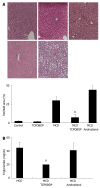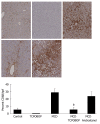Constitutive androstane receptor agonist, TCPOBOP, attenuates steatohepatitis in the methionine choline-deficient diet-fed mouse
- PMID: 17948939
- PMCID: PMC4172744
- DOI: 10.3748/wjg.v13.i42.5635
Constitutive androstane receptor agonist, TCPOBOP, attenuates steatohepatitis in the methionine choline-deficient diet-fed mouse
Abstract
Aim: To ascertain whether constitutive androstane receptor (CAR) activation by 1,4-bis-[2-(3,5,-dichloropyridyloxy)] benzene (TCPOBOP) modulates steatohepatitis in the methionine choline-deficient (MCD) diet-fed animal.
Methods: C57/BL6 wild-type mice were fed the MCD or standard diet for 2 wk and were treated with either the CAR agonist, TCPOBOP, or the CAR inverse agonist, androstanol.
Results: Expression of CYP2B10 and CYP3A11, known CAR target genes, increased 30-fold and 45-fold, respectively, in TCPOBOP-treated mice fed the MCD diet. TCPOBOP treatment reduced hepatic steatosis (44.6 +/- 5.4% vs 30.4 +/- 4.5%, P < 0.05) and serum triglyceride levels (48 +/- 8 vs 20 +/- 1 mg/dL, P < 0.05) in MCD diet-fed mice as compared with the standard diet-fed mice. This reduction in hepatic steatosis was accompanied by an increase in enzymes involved in fatty acid microsomal omega-oxidation and peroxisomal beta-oxidation, namely CYP4A10, LPBE, and 3-ketoacyl-CoA thiolase. The reduction in steatosis was also accompanied by a reduction in liver cell apoptosis and inflammation. In contrast, androstanol was without effect on any of the above parameters.
Conclusion: CAR activation stimulates induction of genes involved in fatty acid oxidation, and ameliorates hepatic steatosis, apoptosis and inflammation.
Figures




References
-
- Angulo P. Nonalcoholic fatty liver disease. N Engl J Med. 2002;346:1221–1231. - PubMed
-
- Bacon BR, Farahvash MJ, Janney CG, Neuschwander-Tetri BA. Nonalcoholic steatohepatitis: an expanded clinical entity. Gastroenterology. 1994;107:1103–1109. - PubMed
-
- Reddy JK, Rao MS. Lipid metabolism and liver inflammation. II. Fatty liver disease and fatty acid oxidation. Am J Physiol Gastrointest Liver Physiol. 2006;290:G852–G858. - PubMed
-
- Waxman DJ. P450 gene induction by structurally diverse xenochemicals: central role of nuclear receptors CAR, PXR, and PPAR. Arch Biochem Biophys. 1999;369:11–23. - PubMed
Publication types
MeSH terms
Substances
Grants and funding
LinkOut - more resources
Full Text Sources
Other Literature Sources
Miscellaneous

